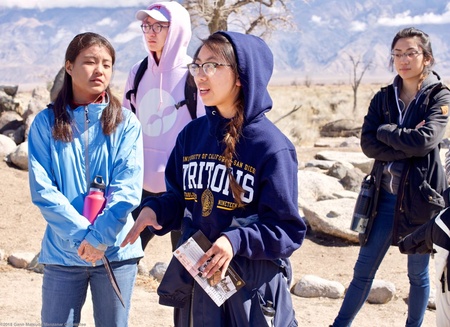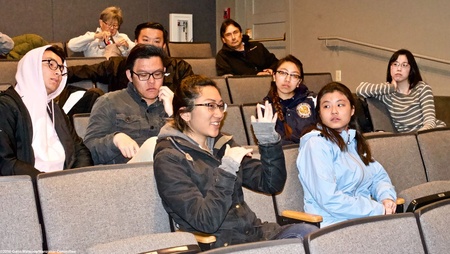Erica Wei, Moet Kurakata, and Lauren Matsumoto were participants in the Manzanar Committee’s pilot project, Keeping Japanese American Incarceration Stories Alive, which took a group of college students to the Manzanar National Historic Site for a two-day, intensive, placed-based learning experience about the unjust incarceration of Japanese and Japanese Americans in concentration camps during World War II.
They shared the following reflections on what they experienced at Manzanar during those two days.
* * * * *

Erica Wei
Leading up to the weekend of the Keeping Japanese American Incarceration Stories Alive trip to the Manzanar National Historic Site, I was actually very reluctant about going. I thought about dropping from participating several times. This was two weeks before final exams and it was one of the last weekends I could use to study for my exams. I was faced with two decisions: Prioritize academics or follow through with my commitment to the Manzanar Committee. Luckily, I chose the latter.
Coming into this project with no expectations, no prior experience of what was going to happen, I was very curious as to what exactly was planned for myself and four other students. We didn’t even know the name of the project. All we were told was that we would be gone mid-Friday to late Sunday. I thought that we were just touring the Manzanar site and doing logistical planning for the upcoming Pilgrimage—while I was partially right, I missed a huge part of the reason we were there.
Words cannot describe how grateful I am to have been able to participate in the Keeping Japanese American Incarceration Stories Alive pilot project. As someone who is not of Japanese ancestry, I never had a familial connection to the incarceration camps and could never fully understand the emotional trauma that Japanese American community faced. Being the Cultural Chair, I’ve done some research and worked with the UCSD Nikkei Student Union to conduct our Day of Remembrance event, but I never truly understood, in detail, what happened in the 1940s. During this two-day learning experience—an intense and emotionally filled weekend—I had the opportunity to learn about Manzanar, not just from a historical perspective, but also from a personal one.
Each day of the project was jam-packed with details and information about Manzanar. We walked through the barracks, gardens, mess halls, play areas, the cemetery—all with a personal story from a former incarceree. I learned and experienced so much that the average individual who visits the site would never have the chance to be a part of.
It is one thing to see photos and read articles online or through a textbook, and it is another thing to experience something first-hand. By participating in this project, I got to see Manzanar with my own eyes and hear the stories of those who were incarcerated with my own ears. From the harsh weather, to almost inedible food, to the extreme lack of privacy, I was moved to tears several times and ached for the community who lost their homes and whose families were broken apart. It became so much more impactful, emotional, and meaningful to have this hands-on participation during this weekend.
I am forever grateful to the Manzanar Committee and to the National Park Service staff at Manzanar National Historic Site for putting together and funding this crucial project. Thank you for allowing myself and the others the opportunity and honor to be the first group of students to have been able to experience this two-day intensive learning weekend. I don’t think I will experience anything else like this and it will forever impact my future involvement within the Japanese American community. Thank you with all my heart.
* * * * *
Moet Kurakata
As a shin-Nisei (second generation Japanese Americans, whose parents are recent immigrants from Japan), I always felt out of place within the Japanese American community in Los Angeles. But this trip made me realize that no matter what generation, age, skin color, or whatever form of identification, Manzanar is a place that impacts you as a member of society.
Hearing the stories of the members of the Manzanar Committee, the park rangers, and fellow students made me realize that Manzanar has so many aspects that reflect human life. This trip has helped me to identify with Manzanar, something I did not feel last year at the Pilgrimage—I identify with the spirit of the Japanese phrase gaman [to endure, persevere] and the beauty behind the incarceree’s efforts to make things a little more tolerable with the building of the gardens, the care the orphanage provided for the children whose futures were changed before they could realize, and the strength of everyone on the Manzanar Committee to keep these stories alive.
I am very grateful I was able to participate in the first of hopefully many programs like this!
* * * * *

Lauren Matsumoto
Visiting Manzanar, for me, has been a time to remember and honor the lives that were forever changed there and at the other Japanese American concentration camps. The stories and lessons I learned about this dark part of history were not taught in school and were not prominently featured in my textbooks. Rather, what I’ve learned came from my own research through the limited books in the library and the brief phone interviews with my grandpa.
My time at Manzanar, this time, was different. Intense and powerful. I felt it was more impacting and meaningful, combining the two, learning more about the history on land where one of the camps stood. I learned in more detail through personal accounts and stories about events I was not aware of before, such as the Native Americans who once lived on the land until they were forced to move.
I’m thankful for the Manzanar Committee and Manzanar National Historic Site rangers for their time and effort to continue to teach and preserve our history.
*This article was originally published in two articles on the Manzanar Committe blog on April 18 and 19, 2018.
© 2018 Erica Wei; Moet Kurakata; Lauren Matsumoto




